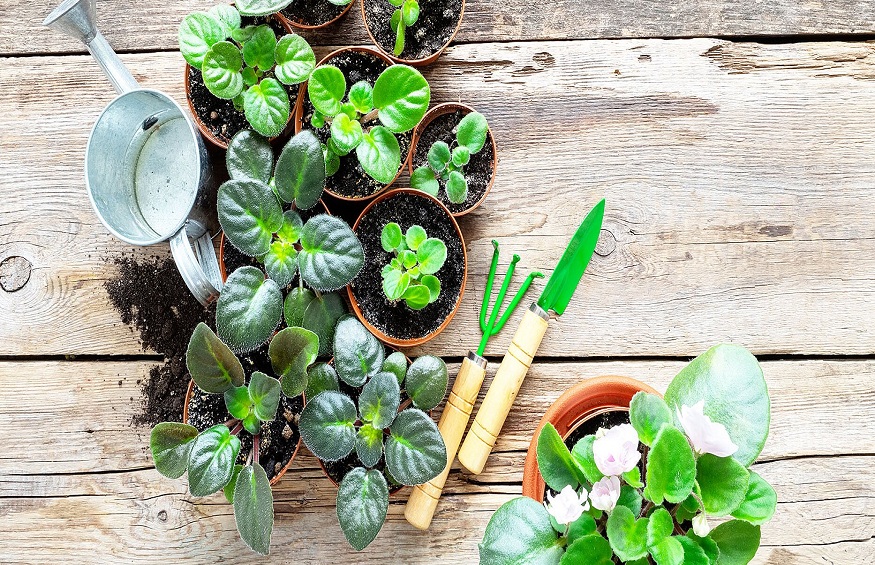An interior garden might be as small as a few pots on the windowsill or as large as a lushly manicured balcony. There are flowers and green plants for every topography, whether you live in the snow-covered northern section of the Indian subcontinent or the land of sunny patches in the south. Green oases come in different sizes and bring a colourful new dimension to your home. Hundreds of years of domesticating plants have resulted in the diverse range of house plants available today. The variety of plants suitable for home gardening is immense, and exotic species are added every day.
The trick is to figure out which types are best for you and your space while avoiding being lost in the beautiful indoor plant forest. Grouping plants together is one of the finest ways to show off your unique sense of style and knowledge of houseplants. Plant grouping is no longer just for aesthetic purposes; it also aids plant growth. They form their society, and plants that grow in groups consistently outperform plants that thrive alone.
When foliage plants are gathered together and shown as a single unit, they look considerably more appealing. Plants in different pots can be brought together and arranged in a cluster on the floor or windowsill to make a fantastic show with various forms, colours, textures, and foliage patterns. Individual liner pots (plastic pots used in nurseries) can be grouped in a larger decorative pot. Plants that are put together in one container make the most beautiful displays.
Here, we’ll go through the various plant requirements and design aesthetics to bear in mind while grouping plants. When planting plants in one container, only one guideline must be followed: all plants must have the exact requirements. You can’t put a succulent next to a fern because moisture is beneficial to one but harmful to the other. Plants that are always seen as compatible are essential, and you can create your displays. Order plants online and greenery and freshness to your living space.
The most basic method is to arrange plants of the same type or family together. Make a desert garden by combining different types and colours of cactuses, or create a magnificent desert terrarium by combining succulents of various types and colours.
Combine erect zebra haworthia with succulents of different shapes, such as echeveria (flatter), and add a flowing shape with a String of Pearls or donkey’s tail. A moon cactus or variegated crassula is one way to add colour to this.
One of the essential parameters of categorization is shape. A display might be spherical, conical, horizontally flat, vertically columnar, or triangular. A complimentary planter form can be used to emphasize any shape better.
Use a moss stick to help vines like philodendron ascends in a tall pot and match it with a Ficus species to balance the height. Allow a trailing variety to grow down the sides of the tall planter to provide depth.
Combine a Spathiphyllum with an Aglaonema or a small cobra fern for a more subtle combination. A dracaena can be added for height and variety of foliage. Send indoor plants online to your family and friends and help them live happy and healthy life.
When building a hanging basket of grouped plants, the goal is to keep the leaves minimum.
Plants with delicate leaves in contrasting colours and shapes, such as spider plants, rabbit’s foot fern, and a wispier philodendron like the broken heart, should be combined.
Bring together brilliantly coloured plants like croton or red aglaonema with mellower leaves like ferns or peperomias to lend colour to a group. As a ground cover, you can choose trailing varieties like sedum.
On a moss stick, mix flowering plants like kalanchoes with peperomia, fittonia, and philodendron. The concept is to combine brilliantly coloured flowering plants with darker green foliage in contrasting forms and patterns. Order Kalanchoes online and add colours and freshness to your garden.
Bamboo palms thrive alongside variegated peperomia, Fittonia, and a Ficus Benjamina to create your tropical forest.
Never underestimate the influence a decent planter can have on your area when arranging plants. Don’t be hesitant to invest in a lovely planter. An excellent traditional planter can last a lifetime and can be used for various plants season after season. Metallic planters provide a touch of luxury to a room, while colourful ceramic planters provide much-needed colour patterns to break up the monotony. White minimalism and monotone planters lighten and open up the room.
Plant grouping is a terrific technique to make something fascinating out of the same standard and readily available house plants. It allows you to personalize your environment and have a one-of-a-kind piece that no one else has. It brightens corners and draws attention to areas that are sometimes overlooked.
So bring out your creative hat and start looking at plants differently, pondering whether this plant would complement the other and simply mixing and matching.




